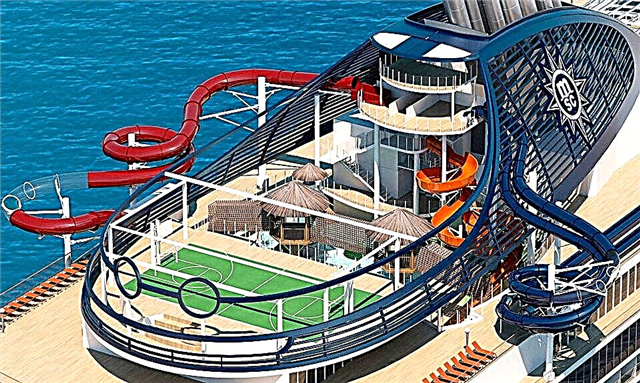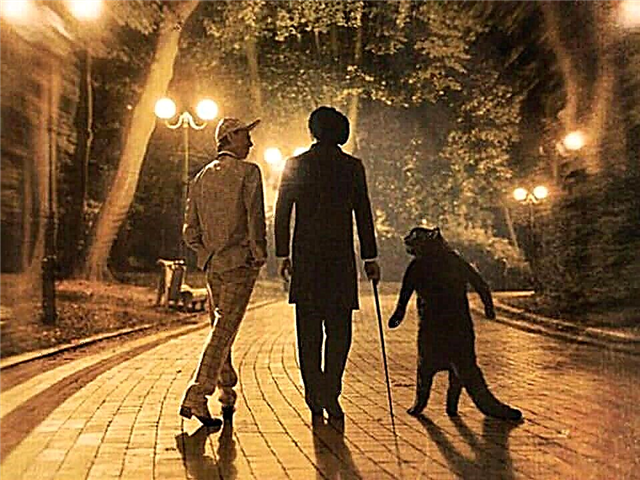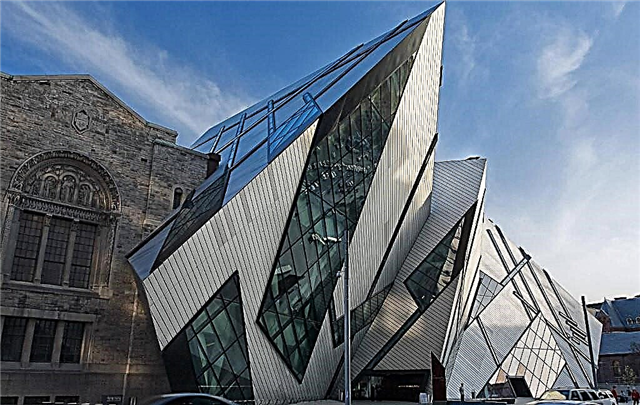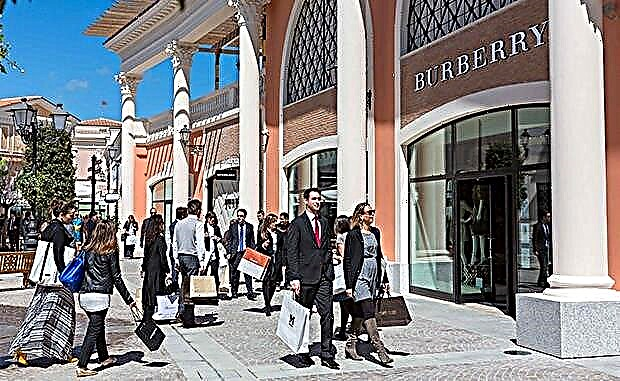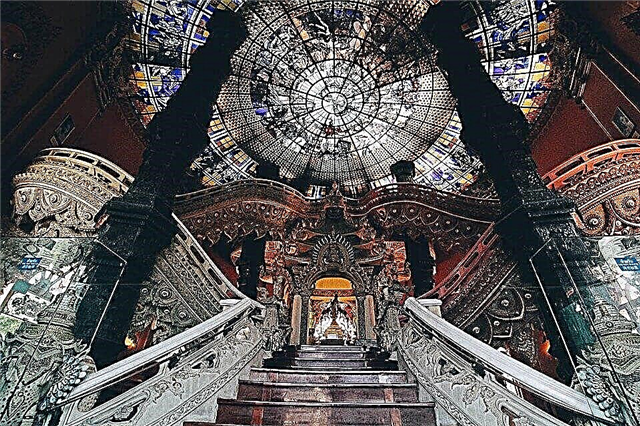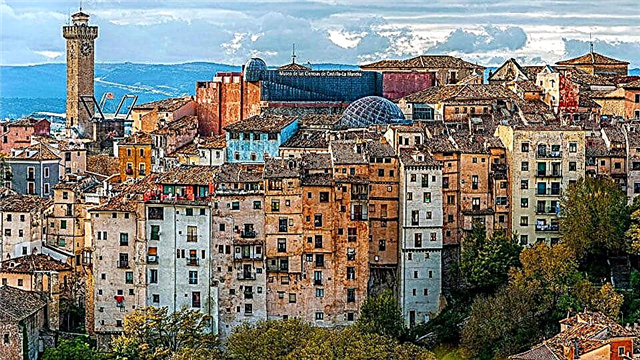Arriving in the capital of Spain Madrid, captivating with skilful medieval architecture, unique historical monuments and a variety of museums, tourists get an unforgettable experience. But when, fortunate enough to spend 7-10 days in the Spanish capital, do not miss the opportunity to visit its surroundings with ancient towns that have survived a thousand-year history, preserved in the historical and architectural monuments the magical atmosphere of the Middle Ages. Each of these towns has unique historical and art museums, whose exhibits tell about the history of the country, the life and art of its hospitable people. We will show you where to go from Madrid for 1 day on your own, suggesting the most interesting places located near the capital, tell you what you can see there and how to get there faster.
Toledo

Most often, tourists head to medieval Toledo - a UNESCO World Heritage Site, a city of "three cultures" with Christian, Jewish and Muslim traditions. The old town occupies the top of the gorge, offering an amazing view of the Tagus River. It amazes with its luxurious architecture, embodied in the styles of several eras: Romanesque, Gothic, Late Gothic, Renaissance and Baroque.
During the reconstruction, many buildings acquired the features of the local style - Mudejar, expressed in luxurious stone ornaments, colored tiles and towers that look like minarets. Arriving at the Town Hall Square, enjoy the beauty of the majestic Gothic cathedral Catedral Primada, then visit the 15th century fortress: the Alcazar, towering over the city. Art lovers should definitely visit the art gallery with paintings by the famous El Greco.
Toledo is located 72 kilometers south of the Spanish capital. Trains run from Atocha station at intervals of 30 to 60 minutes, no more than 35 minutes. The Himmens buses leave from Plaza España, and the Alsa bus route from Via Lusitana. Direct access to Toledo takes 50 minutes.
Segovia

96 kilometers to the north is the picturesque old town of Segovia, founded by the Romans more than 2 thousand years ago, which received the status of a UNESCO World Heritage Site. The creation of ancient Roman architects is a unique aqueduct. Its monumental structure, consisting of 167 granite arches, and stretching for 818 meters, has become the hallmark of the city. You will be conquered by the formidable view of the medieval royal castle Alcazar, which rises on the top of the cliff.
Royal luxury is seen in the facade and interior decoration of the castle. The decoration of the Throne and Armory rooms with stucco gilded ceilings, antique tapestries, stained glass windows and knightly armor amazes with particular beauty. Among the unique attractions are the Madrid Gate, the Town Hall, the Lozoya Tower, the Renaissance palaces of the Counts of Mansilla and the Marquis del Arco, the amazingly elaborate stone carvings of the Peak and Chains houses.
Of the religious buildings, the building of the Cathedral of St. Mary is admired, with wonderful stained-glass windows, a statue of the "Reclining Christ" and a marble altar. At the art museum, admire paintings by Dürer and Rembrandt. Also of interest are Romanesque temples and medieval monasteries. You can get to Segovia by bus AVANZA in 1 hour 20 minutes and by train in 30 minutes, but the train arrival station is 6 kilometers from the city, so you should go by city bus for another 15 minutes.
Escorial

At 62 kilometers near the foot of the Sierra de Guadarrama, the imagination of tourists is amazed by the sight of the grandiose architectural ensemble El Escorial, erected in the 16th century. The complex combining a monastery with a majestic cathedral, a royal residence with a monumental palace, museums and gardens, a tomb of monarchical dynasties has become a symbol of the country since time immemorial. The Cathedral of St. Lawrence rises in the center of El Escorial.
The northern side is occupied by the Palace of the Infants, and the southern side is occupied by the monastery buildings. Do not be confused by the ascetic palace facade. Once inside, marvel at the interiors and luxurious finishes of the Military Hall and the royal chambers. In the cathedral, the decor is striking with silver, gold and bronze details, many sculptures made by outstanding masters. On the walls and ceilings, you will admire the paintings and carvings made by the best painters of the Middle Ages and the famous El Greco.
You should definitely go to the El Escorial Art Museum, where you will see rare paintings by Diego Velazquez, Jose de Ribera, El Greco, Tintoretto, Francisco Goya, Titian, Veronese, Bosch. You can get to El Escorial in an hour from the Madrid bus station by buses No. 661 and 664 in 1 hour. There are also trains and commuter trains from Atocha station to El Escorial, and then a 20-minute walk uphill.
Valladolid

One of the largest cities in Spain, Valladolid is located 195 kilometers north of Madrid. In the Middle Ages, the residence of the Spanish rulers was here, the navigator Columbus found solace. However, the legendary Miguel de Cervantes, the author of "Don Quixote", brought great fame to Valladolid, the first copy of which is kept in his house-museum. In the heart of Valladolid stands the 16th-century Cathedral building with a museum and fragments of an 11th-century church.
The lace building of the National Museum of Sculpture is striking in its external and internal design. It exhibits a rare collection of carved altars, statues of saints, sculptural compositions on biblical subjects made of stone and wood. The museum occupies 3 historical buildings: an architectural masterpiece - the College of St. George, the palaces of Vilena and Casa del Sol, dating back to the 16th century.
You will learn a lot about the history of navigation in the House-Museum of Christopher Columbus. If time remains, relax in Campo Grande Park, where you can admire the lake's fountain and waterfall, walk the royal peacocks and go boating. The AVE high speed train takes you to Valladolid in just 1 hour.
Alcala de Henares

An ancient town with a history of 5 thousand years is stretched 30 kilometers in the direction of the north-east. Its name comes from the Arabic word "al-galat" meaning "fortress", and the word Enares means the name of the local river. It became famous in the first university town of San Ildefonso, founded in the 16th century and which became the prototype of modern scientific centers. The oldest landmarks of the city are the 12th century Gothic church with the Martyrs' Gate and the Bishop's residence, where archival documents of the Inquisition are exhibited.
Don't miss a visit to Cervantes' house, which you will recognize from the figures of Don Quixote and Sancho Panza sitting on a bench near the entrance. The building of the Palace of Laredo, of the late 19th century, and Piazza Cervantes are impressive - a cozy green oasis with luxurious flower beds and storks on the roofs. Of the church buildings, the Church of Santa Maria, where Cervantes was baptized, and the Cathedral of the Holy Children with unique sculptures, murals and paintings of the Middle Ages deserve interest. To Alcala de Henares, there is an electric train up to 25 minutes from the Chamartín station.
San Ildefon

The luxurious royal residence La Granja de San Ildefonso, built in the 18th century on the site of a former monastery, is 80 kilometers away. When approaching the palace, the gaze stops at the Cathedral Church of the Holy Trinity, which was built as the Royal Chapel. The interior design of the temple is amazing, with an altar decorated with three colors of marble: white, red and green, wall and ceiling paintings.
The Royal Palace with the surrounding park was built on the model of the French Versailles. Its baroque architecture amazes with the elegance of the design of the facades, the decoration of the palace halls and rooms.An indelible impression is made by ceiling paintings, wall frescoes and luxurious furniture, harmoniously integrated into the interior, complemented by sculptures, paintings and an impressive collection of tapestries. The beauty of the palace park with lush gardens, flower beds, a French-style labyrinth and a large pond is amazing.
The highlight of the park is a number of original fountains, decorated with sculptural compositions on mythological subjects. The most convenient way to get to San Ildefonso is by rented car in 1 hour 15 minutes along the A-6 motorway and the AP-61 motorway. The rest of the transport will have to go with transfers.
Manzanares el Real

The town and the old castle, located 50 kilometers away. The ancient castle fortress of Castillo de los Mendoza has a tourist attraction. The castle, erected in the 14th century as a defensive fortress, occupies a picturesque section of the southern slope of the ridge. A few decades later, at the end of the 15th century, the fortress was adorned with a palace - the estate of the influential Castilian family of Mendoza. The square structure of the castle-palace is surrounded by a battlement with loopholes and four towers at the corners, three round and one square "Tower of Honor" completed with a hexagon.
Going inside the castle, you find yourself in the armory, surrounded by a two-tier gallery. Enter the main hall of the palace, which displays medieval weapons and knightly armor. Its interior is decorated with 17th century tapestries depicting paintings by Rembrandt. The restoration, carried out in 2013, completely recreated the atmosphere of the Middle Ages, which then reigned in the fortress. The easiest way to get to the castle is by bus, departing from the metropolitan stop Calle Matteo Enurria, located near Plaza Castile. Spend only 45-50 minutes on the road.
Valley of the Fallen

The memorial complex of the Valley of the Fallen, created in the mountains of Guadarrama, should be combined with a trip to the El Escorial architectural complex, located just 15 kilometers from it. The memorial dedicated to the victims of the civil war was erected from 1940 to 1958 during the reign of General Franco. The Valle de los Caidos memorial group combines: an esplanade, a basilica with a crypt and a monument on a granite pedestal in the form of a cross, towering 150 meters. In the galleries carved into the rock, in the wall niches, you will see several chapels where 33,700 Spaniards who died in the civil war are buried. There is a monastery near the complex, whose novices take care of the memorial.
In the Catholic basilica, carved into the rock, the altar dome with a diameter of 42 meters is striking. A mountain trail leads to the foot of the cross, but you can also take a funicular. A breathtaking experience will be the ascent inside the cross by elevator to the observation deck, where at a height of 42 meters, with figures depicting the 4 Christian virtues, a breathtaking view of the surroundings opens. The most convenient way to visit the Valley of Memory is to take a rented car.
Avila

The town of Avila, located 110 kilometers northwest of Madrid, is interesting for its unique history. It stretches along the banks of the Adajo River, flowing at an altitude of 1130 meters. The fortress wall of the 11th century, which has been completely preserved to this day, is recognized as a tourist highlight. The wall encircles the Old Town for 2.5 kilometers. It has 87 towers and 9 gates, and the height of the defensive fortifications reaches 12 meters. After passing through the gates of the Alcazar, you will see the Church of St. Peter, formerly the main temple of the city, on the Big Market Square.
On the Small Market Square there is the Annunciation Chapel dating from the end of the 16th century. The main attraction of Avila is the Church and Museum of St. Teresa of Avila, located on the site of her home. The local 7 churches built in Romanesque architecture and monasteries can be viewed by sitting on the Tren Turistico Murallito ring train in Piazza San Vincento. You can get off it at any stop, view the attraction, and then continue the excursion on another train. From the Moncloa stop to Avila, there is a direct FlixBus on the route K702. Travel time - 74 minutes.
Guadalajara

Guadalajara is located 60 kilometers northeast of Madrid. It was founded by the Arabs in the VIII century, and the name from the Arabic language is translated as "river of stones". The Cathedral of Guadalajara in Plaza de los Caidos was rebuilt after the expulsion of the Arab conquerors in Mudejar architecture in the 14th century from the mosque, retaining from it the tower, which was crowned with a spire. The Renaissance style can be seen in the portico, chapel and magnificent 16th century altar. On the site of a spring that gushed near the temple in the Middle Ages, there is a column with a statue of the Virgin Mary.
Tourists who come to the Plaza de los Caidos are greeted by a monument to Cardinal Mendoza. Behind it flaunts a luxurious 15th century palace, which combines many architectural styles. The internal facades delight with the skillful stone carvings of galleries and arcades. The external facades in a combination of Gothic and Renaissance details evoke an association with a gigantic carved box. On the Calle Mayor square, admire the picturesque eclectic city hall building dating back to the 19th century. Getting to Guadalajara is not difficult by taking a direct train from Madrid station.
Salamanca

Salamanca is famous for the location of the oldest university in Spain, founded in the 13th century. The historical center of the city is under the protection of UNESCO. Tourists enjoy the atmosphere of the old streets with mansions built of golden sandstone. The baroque Plaza Mayor, dating back to the 18th century, has become the center of attraction for visitors to the city. It is bordered by buildings of an authentic Spanish Renaissance style. A visit to two churches deserves attention: the old - Romanesque style, founded in the XII century and the New, built in the architecture of the Spanish Baroque.
The building las Conchas attracts with its originality, with a facade decorated with 300 sea shells. The highlight of Salamanca is the colorful university building of the early 16th century. Its facades with royal coats of arms delight with the plateresque style, expressed by bizarre relief elements of decor and stone patterns. On the outskirts, it is worth looking into a mystical cave, where, according to legend, lessons of black magic, arranged by Satan, took place. Salamanca can be reached from Madrid Chamartin Station in 1 hour 36 minutes, by bus from the Southern Bus Station in 2 hours 20 minutes.
Sigüenza

The small old town of Sigüenza captivates with the flavor of the historic center. In the Plaza Mayor, founded by Cardinal Mendoza in the 16th century, tourists can see the architectural treasury of the city with the charm of the facades of secular buildings, the Town Hall and the Cathedral, the construction of which began in the 12th century in Romanesque architecture, ending almost 400 years later in Gothic. Outside, the cathedral appears as a medieval castle with square towers on the sides and a portico with a massive rose.
Adjacent to the church is a monastery with galleries, which houses a church museum with 16 unique tapestries. The square faces the southern facade with the Gallo tower. Among the civilian buildings, it is worth taking a look at the Gothic tower house on Calle de San Vicente, built in the 13th century. Its façade reveals the heraldry of influential townspeople and details of the Mudejar style. A vivid impression remains from the view of the formidable castle of the XII century, attracting attention on a high hill, which served as a protective structure and the residence of the Bishop. Now the hotel is located within the ancient walls.
Sigüenza is 130 km away. From the station of the same name there is a direct bus number 034. The way to the destination is one and a half hours.
Medinaceli

The settlement of Medinaceli, which existed during the Roman Empire as the city of Ocilis, is located 155 km from Madrid in the Jalon River Valley. The Romans discovered deposits of salt, iron ore and silver here.Today, a reminder of the stay of the Romans is a 9-meter three-span arch of the 1st century AD towering on a hill. An abandoned Moorish castle remained near the arch. Medinaseli is a two-level settlement, the historical part of which is located on a hill. The family palace of the Dukes of Medinaceli stands out among all the mansions on the main square, founded in the 16th century.
Inside the palace, among the exhibitions of newfangled installations, are notable ancient Roman mosaics of the 2nd and 4th centuries on mythological themes, discovered during the restoration of the covering of city squares. Do not pass by the Church of St. Martin, the Monastery of St. Elizabeth dating from the 16th century and the Cathedral of the Virgin Mary with a unique image of Christ, which have preserved the atmosphere of the Middle Ages in the interior. Twice a day, Medinaceli can be reached by train from Madrid, departing at 7.15 and 15.45 in 2 hours 16 minutes.
Colmenar de Oreja

Colmenar de Oreja was founded by the Romans in 220 BC. During the Arab conquest, it became a Moorish fortress. The starting point for sightseeing tours is the authentic Plaza Mayor. The pearl of urban architecture is the Church of Santa Maria la Mayor. Today it appears before us in the form given by perestroika in the 16th century. Outside, the temple looks like an impregnable fortress, completed with a spire of 62 meters. From the cult architecture, it is worth paying attention to the stone chapel-hermitage, named after the patron saint of the city, Humilladero.
The older part was built in the 16th century, the other one a hundred years later. The façade of the Women's Monastery, built in a Baroque architectural look with a right wing, formerly the palace of Count Colmenar, is interesting. Art lovers will be interested in visiting the Ulpiano Checa Museum, a world famous artist who was born in this city. Near the museum, there is a beautiful garden with a bust of the artist, commemorative signs of a jug and a Colmenar stone - limestone, which served as a building material for royal palaces and numerous sculptures.
You need to get there by bus # 337 from Madrid's Conde de Casal train station and get off at your destination at stop 2, focusing on the spire of the church. Travel time is approximately 1 hour.
Consuegra

The settlement of Consuegra has been known since the 6th century BC. The fascinating history and picturesque surroundings are a significant reason to visit the city included in the Don Quixote itinerary. The architecture of Consuegra Castle in the vicinity and the 12 windmills surrounding it, with which the hero of Cervantes fought, became Consuegra's trademark. You will breathe in the medieval atmosphere of the town in the historic Plaza Espana with its 17th century town hall and Los Corredores, featuring traditional La Manche style carved balconies. It houses the city's archaeological museum, where you can see interesting exhibits about the history of Consuegra and Castile.
You will see the ancient Roman dam, built in the 1st century - a testament to the great Roman Empire. Enter the 16th century church of San Juan Buista and admire a collection of paintings by Spanish artists on biblical themes. In the workshops of artisans, you will certainly want to buy traditional and unique ceramics. Consuegra is located 160 km from the Spanish capital. You can get there in 2 hours 45 minutes. bus 012 departing from Madrid station.
Pedraza

The small village of Pedraço, founded in the 13th century, has passed the events and changes of past centuries. Fenced in by a fortress wall, it never went beyond its limits. Today, as in the Middle Ages, you will enter Pedraza through the fortress gate with the emblem of the local ruler, which has retained its appearance unchanged since the 16th century. The medieval era, frozen in the architecture of houses and narrow cobbled streets, fell in love with the creators of historical films and tourists who travel through time here. Immediately after entering Pedraza, you find yourself in the city prison, which has been preserved since the 16th century.
Now it is empty. Passing the narrow Royal Street, you will come to the main square - Plaza Mayor, with the surrounding mansions of the local nobility, in which the town hall and a number of authentic restaurants are located. Tourists will be most interested in the perfectly preserved castle, where every stone of its wall remembers the Romans, Arabs and Spanish Infants, languishing in captivity in the main castle tower. In the last century, the castle was bought by the artist Ignacio Zuloago, who turned it into a museum. From Madrid to Pedraza, the distance is 126 km, the most convenient way to get there is with a rented car.
Aranjuez

Having visited the town of Aranjuez, located 48 km from Madrid between the rivers Tagus and Jarama, tourists will enjoy the view of masterpieces of architecture, wonderful parks and unique collections of museums. The most magnificent building in Aranjuez is the pompous summer Royal Palace, included in the UNESCO World Heritage Site and nicknamed "the Spanish Versailles". It amazes with the luxurious baroque style of the exteriors of the facades and the interiors of its premises. The elegance of the porcelain hall and the luxury of the mirrored salon, the interior of the richly decorated bedrooms, delight.
In the halls of the first floor there are expositions of the museum of the palace life of monarchs. The palace is surrounded by an amazing garden and park complex with four original parks: the heirs to the throne, island, flower garden and Isabel II garden, decorated with sculptures, fountains, pavilions and green fences. In Piazza San Antonio, admire the fountain and the surrounding arcades from the royal court. In the center of the square rises the baroque royal church of St. San Antonio.
Among the attractions are also the museum of royal boats and barges, the miniature building of the Casa del Labrador, the palaces of Medinacelli and Selvilla. In the church of the Royal Monastery of San Pascual, dating from the 17th century, there is an altar painted by the artist Raphael Mengs. A special highlight of Arajuez was the “strawberry train” - an excursion route that recreated an old steam-powered train consisting of 4 trailers with a 19th century interior. After leaving Madrid in 1 hour, he arrives at the railway station, notable for the neo-mudejar style.
Chinchon

A tour of the sights of the city of Chinchon, located 40 km from Madrid, it is better to start from the Plaza Mayor, where you will immediately feel the medieval spirit of the town. The square is surrounded by authentic three-storey houses of the 15th - 17th centuries with wooden galleries-balconies. A popular tourist attraction is the Clock Tower, which served as a church bell tower in the 15th century, and over the centuries turned into a watchtower. Little Chinchon has several churches of interest to tourists.
The Church of the Assumption of Our Lady (1534-1626), combining the architecture of Gothic, Plateresque, Renaissance and Baroque, is famous for the painting of Francisco Goya "Assumption of the Virgin", which adorned the main altar. Do not miss out on the Baroque Church of St. Roca, erected in the 16th century in honor of the patron saint of the city, with a notable sculpture of a saint at the entrance. There are 2 ancient monasteries in Chinchon: the cloister of the Clarice, founded in the middle of the 17th century, and the monastery of the 15th century Augustines, reconstructed at the end of the last century as an authentic hotel.
Next to the Clarice Monastery, the House of Chains, built at the end of the 17th century in Baroque architecture, will attract attention. From here, climb the hill to the ruins of the Castlillo de los Condes (16th century), the ancient stone bridge with the count's coat of arms. From this place you can see an amazing view of the ancient town at a glance. After going downstairs, finish your city tour with a visit to the Lope de Vega theater building, which stands out for its pink facade and the stone coat of arms of the city.
It is not difficult to get there by bus # 337, departing from the Av.Mediterráneo-Conde De Casal station, spending about an hour on the road.
Cuenca

The color of the town of Cuenca, located on a rocky hill 138 km away, is created by a scattering of medieval houses of Casas Colgadas hanging from the cliff. Its main square, Plaza Mayor, is notable for the Baroque architecture of the buildings and the Gothic style of the Cathedral of Santa Maria la Mayor, built at the end of the 12th century. In its interior, admire the XVIII altar by Ventura, a magnificent Renaissance style arch. Next to the temple, go to the courtyard of the Bishop's Palace, where you can see the art collection of the Diocese Museum in the arcaded galleries.
Also, the historical center is interesting for the building of the Cuenca archive, where the Court of the Inquisition was located in the Middle Ages and the Magnan clock tower, recognized as the symbol of the city. Several churches deserve attention: San Felipe de Neri (18th century) with Rococo interiors, Virgen de la Luz dedicated to the Virgin Mary (16th century) with Rococo facades, Baroque Nuestra Señora de las Angustias ( XVI century). The 17th century Baroque Carmelite monastery today houses the university.
You can also visit museums: archeology, painting and fauna. The end of the excursion will be the high hill of Cuenca, where the monument of the Sacred Heart of Jesus rushes to the sky, blessing the city. Tired of the ups and downs of Cuenca's streets, relax in San Ciudad Encantada's quaint rock park. You can get to Cuenca from Madrid with a rented car in 2 hours.
Buitrago del Lozoya

While in Madrid, it is worth visiting the town of Buitrago del Lozoya, located 78 km away. It is notable for the fortress walls surrounded by water, erected by the Moors in the XI century. The old town is spread out on the headland of the river, like an outstretched thumb. Start your excursion from the historical center - Constitution Square with a tour of the old fountain, the city hall, where the museum of paintings by the outstanding artist Pablo Picasso and the Clock Tower is located.
Passing through the tower arch, you will find yourself on the Square of the Fallen near the castle church of St. Mary, erected 7 centuries ago with a facade that stands out for a combination of Gothic, Renaissance and Mudejar architecture. The impressive castle Castillo de Buitrago del Lozoya, built in the 15th century in a square shape, with 7 towers fortification. The main style of the castle masonry is Mudejar. The castle is surrounded by a two-level fortress wall 800m long with three entrances. On the low part of the wall, parallel to the river, you can walk, admiring the amazing views from above. The entrance to the upper - southwest wall is limited.
There is no direct connection to Buitrago del Lozoya. The easiest way to get to the town is in a rented car. Spend 1 hour on the way.


